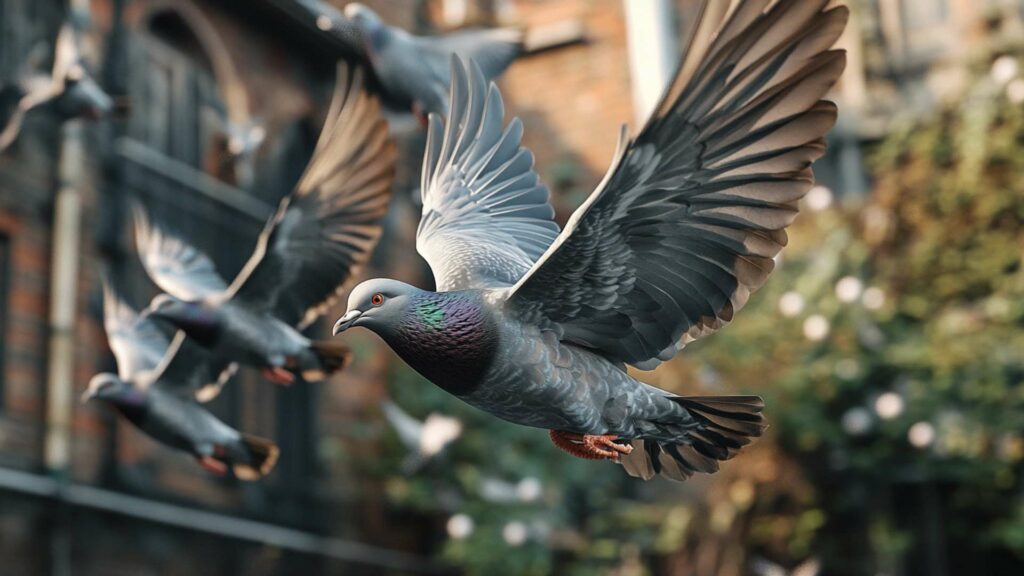Pigeons, those ubiquitous birds that grace our city streets and parks, may seem harmless at first glance. However, it’s essential to address the issues they bring with them.
These pesky pigeons are not just innocent visitors; they can cause a range of problems if left unchecked. Ignoring their presence can lead to detrimental consequences for both human health and the urban environment we inhabit.
Explore our specialized Pigeon Control and Extermination Services provided by our experts. Learn how our professional solutions effectively address pigeon-related concerns. Click to delve into the details of our specialized services designed to tackle pigeon-related issues efficiently.
Potential problems caused by pigeons

One significant concern is the health risks associated with pigeon infestations. Pigeon droppings contain harmful pathogens that can cause diseases such as histoplasmosis and cryptococcosis. These illnesses can be particularly troublesome for individuals with compromised immune systems or respiratory conditions.
Additionally, pigeon droppings are highly acidic and can corrode building materials over time, leading to costly repairs. Another issue arises from pigeons hate the nuisance created by their roosting habits.
Pigeons often gather in large numbers on window sills, rooftops, and other structures, leaving behind a mess of droppings that deface buildings and pose a slipping hazard for pedestrians below. The constant cooing and fluttering of wings may also disturb people’s peace of mind or disrupt their sleep.
Furthermore, pigeons have an uncanny ability to adapt quickly to urban environments due to an abundance of food sources readily available to them. These opportunistic scavengers will happily feast on discarded food scraps or raid pet food left unattended outdoors.
Consequently, their presence not only creates hygiene concerns but also contributes to waste management challenges in urban areas. Given these potential issues caused by pigeons – ranging from health hazards to property damage – it becomes evident why proactive measures should be taken for effective pigeon prevention and control strategies.
In the following sections, we will delve deeper into understanding pigeon behavior, identifying infestations, and exploring non-lethal methods to deter these feathered foes. So, let’s dive in and learn how to keep our surroundings free from the clutches of these persistent winged intruders.
Understanding Pigeon Behavior

A Glimpse into the Natural Habitat and Characteristics of Pigeons
Pigeons, those familiar feathered friends that grace our city streets and parks, have a rich history intertwined with human civilization. Originally derived from wild rock doves, pigeons possess distinct traits that have allowed them to adapt and thrive in diverse environments.
These birds are known for their plump bodies, small heads, and vibrant plumage spanning a range of colors such as gray, white, and various shades of brown. With an average lifespan of 3-5 years in the wild, pigeons are not only sociable creatures but also highly skilled navigators with a remarkable homing instinct.
In their natural habitat, pigeons prefer cliff faces or ledges for roosting and nesting. Their ability to fly long distances with great agility makes them well-suited to urban environments where tall buildings mimic the natural cliffs they would typically inhabit.
Furthermore, pigeons have adapted to survive on a diverse diet consisting mainly of seeds but also encompassing insects and even human food scraps if available. This flexibility allows them to find sustenance amidst our bustling cities.
How to Attract Pigeons
Are you interested in attracting pigeons to your garden or outdoor space? Pigeons, with their gentle demeanor and distinctive cooing, can be a delightful addition to your surroundings. To learn how to entice these feathered friends, check out our comprehensive guide on how to attract pigeons. You’ll discover tips and tricks to create an inviting environment that pigeons will flock to.
How to Keep Pigeons Off Balcony
Tired of pigeons roosting on your balcony and leaving behind unwanted messes? Our article on how to keep pigeons off your balcony provides valuable insights and effective solutions. From bird-proofing techniques to humane deterrents, you’ll find practical ways to reclaim your outdoor space and prevent pigeon intrusions.
How to Keep Pigeons Away from Bird Feeders
Do pigeons disrupt your bird-feeding activities by hogging the feeders? Discover strategies on how to keep pigeons away from your bird feeders while ensuring other avian visitors enjoy their meals. Learn about pigeon-specific deterrents and enjoy a bird-friendly environment.
How to Get Rid of Pigeons in Las Vegas
Dealing with a pigeon problem in the vibrant city of Las Vegas? Don’t worry; you can find effective solutions for pigeon control in our guide on how to get rid of pigeons in Las Vegas. Learn about local regulations, humane removal methods, and how to protect your property from these persistent birds.
How to Trap Pigeons
When it comes to pigeon control, trapping can be a viable option. Discover the techniques and tools needed for successful pigeon trapping in our article on how to trap pigeons. Whether you’re dealing with a few pigeons or a larger infestation, this guide provides valuable insights into humane and effective trapping methods.
How to Pigeon-Proof Solar Panels
Protecting your solar panels from pigeon interference is essential for efficient energy generation. Explore our recommendations on how to pigeon-proof your solar panels. We’ll guide you through the best bird-proofing techniques to ensure your solar investment remains pest-free.
How to Keep Pigeons Away While Sleeping
Do nocturnal pigeon disturbances disrupt your sleep? Learn how to ensure a peaceful night’s rest with our tips on how to keep pigeons away while sleeping. From soundproofing measures to effective bird deterrents, you’ll find solutions to enjoy uninterrupted slumber.
How to Keep Pigeons Out of Your Garage
Pigeons seeking refuge in your garage can lead to mess and damage. Find out how to prevent pigeon intrusions in our guide on how to keep pigeons out of your garage. Discover effective garage bird-proofing methods and ensure your workspace stays clean and pigeon-free.
How to Keep Pigeons Off Porch
Enjoy a pigeon-free porch with our recommendations on how to keep pigeons off your porch. Explore pigeon deterrents and bird-proofing techniques to create an inviting outdoor space that remains pigeon-proof. Say goodbye to unwanted feathery visitors and hello to a serene porch experience.
The Urban Attraction: Why Pigeons Flock to Urban Environments

Urban environments hold an irresistible allure for pigeons due to the abundance of resources that cater to their needs. The concrete jungle provides an ample supply of food in the form of discarded leftovers from street vendors or unconsumed morsels scattered by passersby.
Additionally, open trash cans or improperly sealed waste containers can become veritable feasting grounds for these opportunistic birds. Moreover, buildings offer numerous nooks and crannies where pigeons can establish their nests away from predators’ prying eyes.
Window sills provide ideal perching spots while eaves provide sheltered areas for nesting – safe from the elements. In densely populated areas, where people populate public squares and parks, pigeons can find plentiful sources of food and water, allowing them to flourish.
Pigeons are also drawn to urban environments because they provide a sense of security. Free from natural predators that may threaten them in their native habitats, these avian creatures can thrive undisturbed in cities.
The absence of large birds of prey or other pests that may disrupt their daily affairs further contributes to the preference for urban locales. Understanding pigeon behavior and their affinity for urban environments is crucial when addressing pigeon-related issues.
By comprehending their natural habitat and what attracts them to cities, we can develop effective strategies to prevent pigeon problems and encourage peaceful coexistence with these pesky pigeons. So, let us delve deeper into identifying signs of pigeon infestations and the potential health risks they pose.
Identifying Pigeon Infestations

Signs that Indicate the Presence of Pigeons in an Area
Pigeons are notorious for leaving behind telltale signs of their presence. If you suspect a pigeon infestation, keep an eye out for these common indicators.
First and foremost, pigeon droppings are a dead giveaway. These small, cylindrical droppings can be found on windowsills, ledges, and other elevated surfaces where pigeons roost or perch.
The droppings may appear white at first but turn gray or brown over time. Another sign is the presence of feathers scattered around an area.
Pigeons molt their feathers regularly, so finding feathers on the ground could mean there’s a nearby nest or roosting spot. Additionally, keep an eye out for pigeon nests made of twigs, leaves, and debris tucked away in nooks and crannies like under eaves or in unused corners of buildings.
Differentiating Between Feral Pigeons and Other Bird Species
While it’s important to identify pigeons accurately to implement appropriate control measures, differentiating them from other birds can sometimes be challenging. One way to distinguish feral pigeons from other similar species is by their size and shape. Feral pigeons typically have plump bodies with short legs and small heads compared to other birds like seagulls or sparrows.
In terms of coloration, feral pigeons come in various shades ranging from grayish-blue to brown with iridescent feather patterns on their necks. They often have two dark bands across their wings when seen in flight, which can aid in identification as well.
Observing behavior can also help differentiate pigeons from other birds. Pigeons tend to walk with a distinctive bobbing motion due to their short legs and waddle-like gait.
They are highly adaptable and often seen congregating in large numbers, especially around places where food is readily available, such as parks or areas with outdoor dining. Remember, if you are unsure about the type of bird you’re dealing with or need assistance with pigeon prevention and control, it’s best to consult a professional who can provide accurate identification and effective solutions.
Overall, being able to identify signs of pigeons and differentiating them from other species is key in implementing the right preventive measures. By understanding their behavior and physical characteristics, tackling pesky birds and pigeons becomes more manageable while ensuring the well-being of other birds.
Health Risks Associated with Pigeons
Hidden Dangers in the Air: Diseases Transmitted by Pigeons
When it comes to pigeons, it’s not just their cooing and fluttering wings we need to worry about. These seemingly harmless creatures can pose serious health risks. One of the most concerning diseases linked to pigeons is histoplasmosis.
This fungal infection occurs when humans inhale spores found in pigeon droppings that have dried out and turned into dust. Once inside our bodies, these spores can cause flu-like symptoms, respiratory issues, and even severe lung infections if left untreated.
Cryptococcosis is another disease associated with pigeons, caused by inhaling a fungus that grows on their droppings and nests. It primarily affects people with weakened immune systems and can lead to meningitis or pneumonia.
Allergies Aloft: Potential Reactions to Pigeon Droppings
While pigeons may not be known for their cleanliness, the consequences of their unsanitary habits go beyond disease transmission. Pigeon droppings contain allergens that can trigger allergic reactions in susceptible individuals.
Those with existing respiratory conditions such as asthma or allergies may experience heightened symptoms when exposed to pigeon droppings or feathers. The proteins present in these substances can cause nasal congestion, coughing, sneezing fits, itchy eyes, and skin rashes.
Mitigating the Risks
To protect yourself from these health hazards associated with pigeons: – Avoid direct contact with pigeon droppings or disturbed areas where dust might be present.
– Wear protective clothing such as gloves and masks when cleaning pigeon-infested areas. – Ensure proper ventilation when working in spaces where pigeons roost or nest.
Taking Action: Preventing and Cleaning Up After Pigeons
To decrease the risk of disease transmission and allergic reactions caused by pigeons, it’s crucial to take preventive measures. Regularly clean up pigeon droppings from surfaces like windowsills, ledges, and rooftops using a disinfectant solution.
Additionally, discourage pigeons from roosting or nesting by installing bird spikes on vulnerable areas and blocking access points. Remember to use humane methods that do not harm the birds themselves.
By understanding the health risks associated with pigeons and implementing proper prevention measures, we can create a safer environment for ourselves and our communities. Stay vigilant, keep surfaces clean, and remember that taking action now can prevent potential health complications later on.
Non-Lethal Pigeon Prevention Methods
Implementing Physical Barriers: Netting and Spikes

Picture this: you arrive at your favorite café, ready to enjoy a peaceful afternoon cup of coffee, only to be greeted by a rowdy flock of pigeons perched on every available surface. These situations can be frustrating, but fear not! Implementing physical barriers is an effective way to deter roosting and nesting pigeons.
One popular method is the use of netting. Fine wire mesh netting can be strategically installed to cover areas where pigeons tend to gather, such as eaves, balconies, and windowsills.
The netting prevents access while allowing air circulation and sunlight. Another physical barrier that works wonders is the strategic placement of spikes.
These harmless deterrents discourage pigeons from landing on ledges or rooftops where they typically settle for rest or nest-building purposes. These spikes are made of stainless steel or plastic and are designed to get rid of pigeons and make landing uncomfortable without causing harm to the birds.
Utilizing Scare Tactics: Decoy Predators and Reflective Devices

When dealing with pesky pigeons, sometimes you need to get a little creative in your approach. One effective tactic to scare pigeons is utilizing scare tactics such as decoy predators or reflective devices.
Decoy predators like plastic owls or decoy kites imitate natural predators that pose a threat to birds. Pigeons are intelligent creatures that quickly learn and adapt; placing these fake predators in targeted areas will make them think twice before settling down for a pigeon party.
Reflective objects like shiny aluminum foil strips or reflective tape can also work wonders in deterring pigeons. They create an optical illusion that disturbs their flight patterns as they see flashes of light reflecting off these surfaces.
Pigeons dislike unpredictability, so these reflective devices keep them on their wings and away from your property. Remember, when using scare tactics, it’s important to periodically change the positioning or appearance of these pigeon deterrents too.
Pigeons are clever and will eventually catch on to the ruse if nothing changes. Get creative and experiment with different methods to find what works best for your specific pigeon problem.
Non-lethal pigeon prevention methods provide effective alternatives for deterring these feathered troublemakers. Implementing physical barriers like netting and spikes denies pigeons access to their preferred feeding seed roosting and nesting spots.
Scare tactics involving decoy predators or reflective devices disrupt their comfort zone and keep them searching for a more peaceful perch elsewhere. By employing these non-lethal methods, you can strike a harmonious balance between discouraging pigeons from your property without causing harm to these birds or disturbing other wildlife in the process.
Humane Trapping and Removal Techniques for Pigeons

The Ethical Considerations in Dealing with Pigeon Populations
Pigeons, often referred to as “rats with wings,” are a common sight in urban environments. While they may be considered a nuisance due to their droppings and potential damage, it is essential to approach pigeon control ethically.
As sentient creatures, pigeons deserve our respect and humane treatment. When dealing with pigeon populations, it’s crucial to consider the most compassionate methods available.
Live trapping is one such method that allows for the safe removal of pigeons without causing harm. There are various types of live traps available that are specifically designed for keeping pigeons out.
These traps are typically constructed with wire mesh and include entry points that allow the birds to enter but not exit. Once trapped, pigeons can be easily relocated to a more suitable habitat away from populated areas.
Explanation of Live Trapping Methods and Relocation Options
Live trapping methods involve setting up traps in targeted areas where pigeon activity is high. Common locations include window sills, rooftops, or ledges where pigeons frequently roost or nest.
To entice the birds into the trap, bait such as cracked corn or sunflower seeds can be used. Additionally, creating an environment that discourages pigeons from roosting—such as removing potential food sources like pet food or keeping windowsills clear—can increase the effectiveness of live trapping.
Once captured, it’s imperative to handle the pigeons with care and avoid causing unnecessary stress or harm during transportation. Prioritize their well-being by providing adequate ventilation within transport containers and ensuring they have access to water during relocation.
As for relocation options, finding suitable habitats away from human habitation is critical for both animal welfare and preventing conflicts with other bird species. Large parks or nature reserves with ample food sources and suitable shelter are ideal choices.
However, it’s essential to consult local wildlife authorities or animal welfare organizations to ensure compliance with regulations and to obtain guidance on responsible relocation practices. When addressing pigeon control, ethical considerations must guide our actions.
Live trapping offers a humane approach for removing pigeons from areas where they cause problems. The use of proper trapping methods, such as baiting and strategically placing traps in known roosting areas, can significantly increase success rates.
Additionally, ensuring the safe relocation of captured pigeons to appropriate habitats is crucial for their well-being and the preservation of ecosystem balance. By approaching pigeon control with compassion and respect for these intelligent birds, we can find effective solutions that benefit both humans and pigeons alike.
Pigeon Repellents: Chemical Approaches
An overview of chemical repellents available on the market
When it comes to dealing with a pesky pigeon problem, chemical repellents can be a viable option. There are several types of repellents available on the market that claim to deter pigeons and discourage them from roosting or nesting in unwanted areas.
One common type is bird gels, which are sticky substances that make surfaces unpleasant for birds to land on. These gels create an uncomfortable texture for pigeons, making them look elsewhere for a place to perch.
Another option is the use of bird spikes, which are long and narrow strips made of plastic or metal with pointed ends. These spikes prevent pigeons from perching or landing on ledges, roofs, and other areas where they tend to congregate.
The sharp points create an uncomfortable surface that discourages pigeons from settling down. Sticky traps are also available as a chemical means for pigeon control.
These traps feature an adhesive surface that captures birds when they come into contact with it. They can be placed strategically in areas where pigeons gather most frequently, such as near bird feeders or around nesting sites.
Exploration of their effectiveness in deterring pigeons
While chemical repellents may seem like effective solutions at first glance, their success in deterring pigeons can vary depending on several factors. Pigeons are intelligent creatures and may adapt their behavior to overcome these deterrents over time. Bird gels can be effective initially since the sticky texture is unpleasant for birds’ feet and feathers.
However, extreme weather conditions like rain or excessive heat can diminish the efficacy of these gels. Additionally, prolonged exposure to sunlight might cause them to harden or become less sticky.
Bird spikes have proven successful in many cases by preventing pigeons from landing on desired surfaces. However, gaps between the spikes or incorrect installation may allow pigeons to find alternative perching spots.
Regular maintenance and inspection are crucial to ensure the spikes remain intact and effective. Sticky traps can be a hit-or-miss solution.
While they have the potential to capture other pest birds and pigeons, they can also inadvertently trap other birds or even small animals. Moreover, they require frequent monitoring and cleaning to prevent overcrowding and unsanitary conditions.
Chemical repellents offer a range of options for pigeon control but must be used with caution and as part of a comprehensive approach to deter these persistent birds. It is advisable to consider combining chemical repellents with other preventive measures, such as physical barriers or architectural modifications, for a more effective long-term solution in managing pigeon populations.
Permanent Solutions for Long-Term Control
Proper Building Maintenance Practices to Prevent Access Points for Roosting/Nesting
When it comes to tackling persistent pigeon problems, one of the most effective strategies is implementing proper building maintenance practices. By addressing potential access points for pigeons roosting and nesting, you can significantly reduce the appeal of your structure to these feathered troublemakers. To begin with, regularly inspect your building’s exterior for any cracks or crevices where pigeons might find a cozy spot.
Pay special attention to areas around windowsills, roofs, and ledges. Seal these areas with durable materials or caulk to create a barrier that pigeons cannot penetrate.
Additionally, block chimneys and vents using wire mesh or screens designed specifically for preventing bird intrusion. Maintaining cleanliness is also crucial in deterring pigeons.
Promptly remove any spilled food or water sources that may attract not only pigeons but also smaller birds that they often flock with. Regularly sweeping outdoor areas can help prevent leftover food from becoming an enticing feast for these birds.
Consideration of Architectural Modifications to Make Structures Less Attractive to Pigeons
In addition to proper maintenance practices, architectural modifications can be employed to make structures less attractive and accessible to pigeons. These modifications aim at altering the physical environment in a way that discourages roosting and nesting.
One effective modification is the installation of bird netting. This durable mesh-like material can be strategically placed over open spaces such as balconies or rooftops where pigeons tend to congregate.
Bird netting denies them access while still allowing air circulation and maintaining aesthetic appeal. Another useful modification involves reducing available perching opportunities on ledges or roof edges by attaching small perches that are too narrow for pigeons to comfortably rest on.
These perches deter pigeons while posing no inconvenience to humans or smaller birds that are not considered pests. In some cases, architectural features like solar panels can inadvertently attract pigeons.
To discourage pigeons from roosting beneath solar panels, consider installing deterrents such as reflective objects or flashing lights. These visually disruptive elements make the area less inviting for pigeons while not affecting the functionality of the solar panels.
By combining proper building maintenance practices and thoughtful architectural modifications, you can create an environment that discourages pigeons from roosting and nesting on your property. This proactive approach provides a long-term solution to your pigeon problem, making it easier to maintain a clean and pest-free living or working space.
Community Involvement in Pigeon
Engaging the Community
One of the most effective ways to address pigeon problems is by involving the community in prevention and control efforts. Educating residents about pigeon behavior and the potential risks associated with infestations can create awareness and a sense of responsibility among community members. Organizing workshops, distributing informational pamphlets, or hosting neighborhood meetings are excellent ways to engage the community in preventing pigeon issues.
Cooperating with Local Authorities
Collaboration with local authorities, such as city councils or animal control agencies, can yield substantial results in addressing pigeon problems. By reporting sightings or areas heavily infested with pigeons, community members can prompt timely action from these authorities. Encouraging proactive measures like implementing building codes that prevent roosting or nesting sites can contribute to long-term solutions.
Implementing Community Programs
Establishing community programs that focus on proper waste management and reducing food availability for pigeons is another crucial aspect of controlling their population. Encouraging residents to secure trash bins, avoid feeding pigeons directly (and instead a bird feeder for them separately in designated areas if desired), and properly dispose of food waste can help deter pigeons from congregating in residential areas.
Conclusion
While dealing with pesky pigeons may seem like an overwhelming challenge, it is not insurmountable. Through a combination of non-lethal prevention methods, humane trapping techniques where needed, chemical repellents if necessary, architectural modifications for long-term pest control only, and active community involvement, we can effectively manage pigeon populations while minimizing risks to human health and property damage. Remember that prevention is key; taking proactive measures like installing bird spikes or netting on window sills or using reflective devices such as wind chimes near solar panels will repel pigeons and prevent them from establishing roosting or nesting sites.
By coming together as a community and being vigilant in our efforts to feed pigeons, we can create an environment that is less attractive to pigeons while promoting the well-being of other bird species such as mourning doves and smaller birds. Let us strive for a harmonious coexistence with all living creatures, including the beautiful yet sometimes troublesome pigeons.
Frequently Asked Questions:
Home remedies like reflective objects, scare tactics, or netting can help deter pigeons.
Quickly getting rid of pigeons can be achieved using deterrents like spikes, nets, or professional pest control.
WD-40 is not effective for pigeon removal.
Yes, pigeons can be controlled using various methods, including deterrents and professional pest management.







